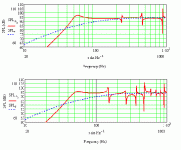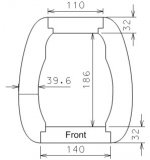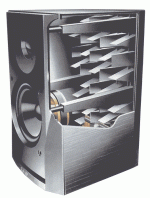Well, assuming it's a BR, then you want as even an air particle density / distribution as possible, which is most easily attained by using golden ratio. Sticking to this should itself minimise standing waves. The overall dimensions of an enclosure do have a considerable effect on its behaviour. See the attached FR plots: two cabinets, tuned to the same frequency, with very different harmonic resonances due to their respective geometries. The first is an untapered box, the second is expanding. Basically, an MLTL & a (ML) TQWT.
Smaller internal differences such as those you're proposing should theoretically break up some resonant modes a little, in the same way that, say, room diffusors do. However, as pointed out above (IIRC, Linkwitz also mentions this WRT rooms), this can be a bit of a double edged sword as you're going to move them around & make it harder to predict in advance where exactly they're going to be. Having said that, I'd say it's worth doing, especially if you happen to be using drivers with paper diaphragms, if for no other reason than it should help reduce the potential for direct reflections from the rear cabinet wall back through the cone. The devil is usually in the detail. And if you can shift standing waves to a higher frequency, these tend to be more easily dealt with, requiring proportionally less damping.
YMMV of course.
Smaller internal differences such as those you're proposing should theoretically break up some resonant modes a little, in the same way that, say, room diffusors do. However, as pointed out above (IIRC, Linkwitz also mentions this WRT rooms), this can be a bit of a double edged sword as you're going to move them around & make it harder to predict in advance where exactly they're going to be. Having said that, I'd say it's worth doing, especially if you happen to be using drivers with paper diaphragms, if for no other reason than it should help reduce the potential for direct reflections from the rear cabinet wall back through the cone. The devil is usually in the detail. And if you can shift standing waves to a higher frequency, these tend to be more easily dealt with, requiring proportionally less damping.
YMMV of course.
Attachments
Thanks for the advice guys.
I must admit I am a bit confused now It seems we have the full circle:
It seems we have the full circle:
1. It could actually be bad
2. It won't do any good (or bad for that matter)
3. It could help
The main reason - or so I always thought (and actually still do) - many manufacturers stick to square boxes with little if any attention paid to standing wave reduction other than tweaking dimension ratios and adding a little stuffing is that of economics. If cost is of lesser importance then you start to see more exotic box shapes.
Am I correct in saying that standing waves are an issue that should be addressed (this is DIY after all so adding a few dollars wouldn't hurt too much)?
I am building a "small" surround speaker using a 4" Seas mid and 3/4" tweeter. The box is made from layered walnut. I cut 1" thick planks into rounded shapes (difficult to explain without a pic but I don't have one ATM) and stuck them together - much like this: http://www.humblehomemadehifi.com/Humble_Statement.html
The sides of the boxes are rounded and they taper from the front to the back. Only the front and back panels are parallel. The front panel is about 1.75 times wider than the back one. At no point is the wall thickness less than 1.5" thick so these boxes are VERY sturdy - no chance of the sides playing along! I was just wondering if there is any chance of the two parallel sides messing things up. It is a BR design.
I've seen anechoic chambers where the walls and ceilings are covered in wedge shaped material. Presumably to combat standing waves? If this applies outside the box why not inside? Is it because the box is too small for standing waves to form? What about midrange frequencies?
Thank you all!
I must admit I am a bit confused now
1. It could actually be bad
2. It won't do any good (or bad for that matter)
3. It could help
The main reason - or so I always thought (and actually still do) - many manufacturers stick to square boxes with little if any attention paid to standing wave reduction other than tweaking dimension ratios and adding a little stuffing is that of economics. If cost is of lesser importance then you start to see more exotic box shapes.
Am I correct in saying that standing waves are an issue that should be addressed (this is DIY after all so adding a few dollars wouldn't hurt too much)?
I am building a "small" surround speaker using a 4" Seas mid and 3/4" tweeter. The box is made from layered walnut. I cut 1" thick planks into rounded shapes (difficult to explain without a pic but I don't have one ATM) and stuck them together - much like this: http://www.humblehomemadehifi.com/Humble_Statement.html
The sides of the boxes are rounded and they taper from the front to the back. Only the front and back panels are parallel. The front panel is about 1.75 times wider than the back one. At no point is the wall thickness less than 1.5" thick so these boxes are VERY sturdy - no chance of the sides playing along! I was just wondering if there is any chance of the two parallel sides messing things up. It is a BR design.
I've seen anechoic chambers where the walls and ceilings are covered in wedge shaped material. Presumably to combat standing waves? If this applies outside the box why not inside? Is it because the box is too small for standing waves to form? What about midrange frequencies?
Thank you all!
GerhardW said:Thanks for the advice guys.
I must admit I am a bit confused nowIt seems we have the full circle:
1. It could actually be bad
2. It won't do any good (or bad for that matter)
3. It could help
You're welcome!
I know -it can get confusing. However, it won't be bad, & should help a bit. Whether or not it would be an audible improvement or not; well, there's only one certain way to find out.
If you're building a BR cabinet, anything that breaks up potential standing waves is a good thing. You don't want any at all in a BR cabinet.
The main reason - or so I always thought (and actually still do) - many manufacturers stick to square boxes with little if any attention paid to standing wave reduction other than tweaking dimension ratios and adding a little stuffing is that of economics. If cost is of lesser importance then you start to see more exotic box shapes.
Quite right.
Am I correct in saying that standing waves are an issue that should be addressed (this is DIY after all so adding a few dollars wouldn't hurt too much)?
Well, I think so, at least for any cabinet that isn't deliberately using the aforementioned standing waves in a positive sense. The devil is in the detail. One small change rarely does much, but there's a cumulative effect of lots of small improvements.
The sides of the boxes are rounded and they taper from the front to the back. Only the front and back panels are parallel. The front panel is about 1.75 times wider than the back one. At no point is the wall thickness less than 1.5" thick so these boxes are VERY sturdy - no chance of the sides playing along! I was just wondering if there is any chance of the two parallel sides messing things up. It is a BR design.
Don't kid yourself: the panels will still resonate, but they're unlikely to do so in its operating BW, so you'll be fine. Nice materials BTW. No, if you damp the back-wall of the cabinet, you shouldn't have any problems. The horizontal standing waves that will occur will be at a wavelength easily absorbed by the damping material.
I've seen anechoic chambers where the walls and ceilings are covered in wedge shaped material. Presumably to combat standing waves? If this applies outside the box why not inside? Is it because the box is too small for standing waves to form? What about midrange frequencies?
No, they still do form. It's just that they're at higher frequencies, which is fine, because the shorter wavelengths are more easily handled by the damping material present. There are in fact boxes which are internally layered. A box is just a small room, after all. However, it's easy to go too far with damping & suck a lot of the midrange life out, as well as killing bass response. It's all about striking a happy medium.
Svante said:Nope.
Changing the geometry of a box has little effect on the resonances other than moving their frequencies. .....
I got some different experiences on that 'geometry' thing.
Once I designed a box for a friend (to accommodate his Altec 605 coax). I made it with 'toe-in' front baffle which is very much like the NHT, just bigger. The result was very good.
Later, he wanted another pair with not-so-aggressive look. So I drew a regular rectangular shape with 'golden ratio' proportion. Then he built them and compared to the previous one with tilt-in baffle, he stated that the oblique one sounded much better.
I also gave them a listen and agreed. Even with golden ratio (and 3/4" ply with some internal braces), the rectanglar box sounds like, er, a box. Some resonant peaks just plainly audible.
Comparing with that, with the same (almost, I should say) internal volume and tuning, the previous one with tilted baffle just sounded much more clean and flat in response. Much much less of that 'box' sound.
Common boxes with internal distances of several tens cm between main surfaces, which can form standing waves of up to midband frequency.
No matter those standing waves cause interaction with driver to boost up some impedance peaks (and further interact with amps), or simply re-radiate in some forms through the accoustically transparent diaphragm, they are audible.
So I always think unparallel walls can do good things.
The physics behind it is that standing waves form best between parallel faces and the wavelength of such standing waves is a multiple of the perpendicular distance between them. So technically you do "move" the waves by putting wedges but that actually understates what happens because these move several octaves up and then, as others have pointed out, it is much, much easier to damp them.
That is why spherical enclosures have the most desirable properties as far as standing waves go.
-Ram
That is why spherical enclosures have the most desirable properties as far as standing waves go.
-Ram
s7horton said:MDF is more uniform in density than walnut.
Uniform density means that at certain frequencies the cabinet can become acoustically transparent...
IMHO MDF is just not a very good material to make cabinets out of.
On the actual subject, i always liked what they did in the B&W DM302...
dave
Attachments
Gerhard,
there is a cheap & easy way to get excellent results: corrugated cardboard ( yes, really - the stuff your Xmas presents come in! ).
Just cover one panel with it - not flat on but perpendicular, with the "channels" pointig at the opposite panel...10cm thickness will do, and thew result is quite amazing (plus, by cutting up surplus cartons you get a bit more lebensraum in yout basement)
Have fun,
Pit
there is a cheap & easy way to get excellent results: corrugated cardboard ( yes, really - the stuff your Xmas presents come in! ).
Just cover one panel with it - not flat on but perpendicular, with the "channels" pointig at the opposite panel...10cm thickness will do, and thew result is quite amazing (plus, by cutting up surplus cartons you get a bit more lebensraum in yout basement)
Have fun,
Pit
- Status
- This old topic is closed. If you want to reopen this topic, contact a moderator using the "Report Post" button.
- Home
- Loudspeakers
- Multi-Way
- Minimising standing waves


